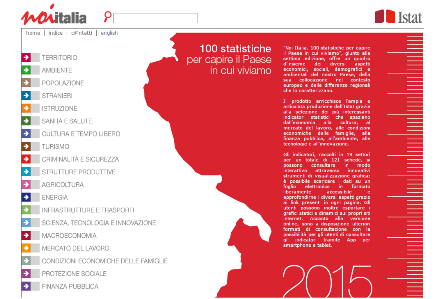
 Umberto Mucci
Umberto Mucci
Italian good news: Noi Italia and We the Italians (part 1)
- WTI Magazine #54 Feb 20, 2015
-

 Umberto Mucci
Umberto Mucci
WTI Magazine #54 2015 February, 20
Author : Umberto Mucci Translation by:
The National Institute for Statistics (Istat) has released its report called "Noi Italia. 100 statistiche per capire il Paese in cui viviamo" (Noi Italia. 100 stats to understand the Country we're living in"). The report provides an overview of the various economic, social, demographic and environmental characteristics of our country, of its position in the European context and the regional differences that characterize it.
The selection involves 121 indicators, collected in 19 areas, ranging from economy to culture, to the labor market, the economic conditions of the families, infrastructure, public finance, the environment, technology and innovation. Many are the bad news, or the ones that see us behind in comparison with the other European countries. But We the Italians always look at the bright side, and so we'll tell you something about the good news in the report, not forgetting that Italy has a lot of homework to do to get better and better. We'll divide this analysis in two articles, this is the first one, the second will be in the next issue of our magazine.
Territory
In 2014 the natural protected areas cover 19.3% of the national area, placing Italy above the average of the 28 EU members (18.1% in 2013). Protected areas at sea constitute 3.7% of the surface of the national waters.
Environment
In 2013 the urban green represents 2.7% of the territory of the provincial cities, 0.7% more than the previous year. In total, that's more than 577 million m² (222.78mi²), or 32.2 m² (346.60ft²)per inhabitant.
About waste disposal, Italy is far above the European average, with about 215 kg (473.99lb) per capita. 42.3% of municipal waste goes to separate waste (+2.3 percentage points compared to 2012), with strong differences between North and South: the Northeast has the highest rate with 58.8%.
Population
In Europe, Italy is confirmed as the fourth country for demographic importance after Germany, France and the UK. In 2013, the average life expectancy for women is 84.6 years, that of men is of 79.8 years: the longest of the European Union.
At January 1, 2014, in Italy there are 154.1 seniors every 100 young people. Liguria is the oldest region, while Campania region is the youngest. In Europe, only Germany has a more pronounced aging index (158.4).
In 2013 the number of celebrations of marriages (3.2 per thousand inhabitants) decrease, a trend common to all European countries. In the South people get married more than in the Centre-North (3.8 compared to 2.9 per thousand), while the Northwest has the highest rate of marriages celebrated in a not religious ceremony (55.3%). Italy has a low incidence of divorces (0.9 per thousand inhabitants in 2012): at European level, only Ireland records lower values.
Immigrants
At January 1, 2014, In Italy we have over 3 million 800 thousand regular non-EU citizens, about 110 thousand more than the previous year. The inflow in our country fell by 3.2% in a year: the decline in new arrivals affects more women (-5%) than men (1.4%).
Foreigners residents in Italy from age 15 to 64 have a level of education similar to that of the Italians. The foreign labor force represent 11.2% of the total, concentrated for over 60% in the North. The inactivity rate of the foreign population is nearly eight percentage points lower than that of the Italian population (29.7 versus 37.3%). The employment rate is, on the contrary, higher than that of the Italians (61.9 compared with 59.5%), as the unemployment rate (17.3 and 11.5% respectively).
Education
In Italy, the incidence of spending on education on the GDP is 4.2% in 2012, a figure close to that of Germany and Spain but lower than dell'Ue28 (5.3%). In 2013, 42.2% of the population aged between 25 and 64 years received his higher license as the middle school degree. 22.4% of Italians between 30 and 40 years old holds a university degree (or equivalent); this share increased by 6.8 percentage points between 2004 and 2013.
Healthcare
The infant mortality rate continues to decline throughout the Italian territory, reaching values among the lowest in Europe. In 2011 it was at 3.1 deaths per thousand newborns, which is only slightly less than that observed in 2010 (3.2).
Diseases of the circulatory system are the leading cause of death in almost all EU countries. In Italy mortality for these causes is among the lowest in Europe with a value in 2011 of 29.4 deaths per ten thousand inhabitants. Tumors are the second cause of death both in Italy and in the group of 28 EU countries. The Italian rate (25.6 deaths per ten thousand inhabitants, slightly down compared to the value of 25.9 in 2010) is right below the EU average.
On the subject of lifestyles, Italy has the lowest percentage of obese people of the EU (10.3% of the population aged 18 and over). Smokers and hard liquor drinkers in 2013 are, respectively 20.9% and 13.4% of the population aged 14 and over, down compared to previous years.
Culture and spare time
In 2014, 41.4% of Italians read at least one book in their spare time, with a prevalence of female readers (48%) on male readers (34.5%). The North reads more (49% in the Northeast and 48.1% in the North-west) than the South (29.9%).
Just under one Italian in two (47.1%) read a newspaper at least once a week and, of these, 36.5% read it at least five days a week. More and more people use the network for reading newspapers, or news magazines: from 11% in 2005 to 31% in 2014.
Cinema is confirmed at first place among the cultural activities in 2014. The 47.8% of the population aged 6 and over has seen at least one movie in the theater. Visits to museums and exhibitions and sports events have instead involved at least a quarter of the population.
The long-term data show an increase in the propensity to sports (from 26.8% in 1997 to 31.6% in 2014). Between 2013 and 2014, in particular, we see a growing proportion of those who do sport on an ongoing basis (from 21.5% to 23%) while decreases the percentage of those who do sports just on a random basis (from 9.1 to 8 , 6%).
Tourism
In 2013 in Italy there were more than 124.000 shops and enterprises extra hotel in the tourism business, 0.6% more than in 2012; hotels are slightly down (-1.2%), equivalent to about 33 thousand. The Italian offer is higher than those of Germany, Spain and France and less, among others, of the offering of Croatia, Austria and Greece.
In 2013 we had 104 million arrivals, with about 380 million visitors (slightly up in the first and down in the second data, compared to 2012). In 2013, travel to Italy with overnight by residents for reasons of holiday and work represent 79.9% of the trips. The most visited Italian regions by residents are Tuscany, Lombardy, Emilia-Romagna, Lazio and Puglia, which hosted 47.6% of tourist flows.